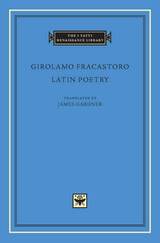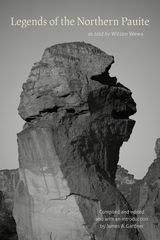4 books by Gardner, James

Christiad
Marco Girolamo Vida
Harvard University Press, 2009
Marco Girolamo Vida (1485–1566), humanist and bishop, came to prominence as a Latin poet in the Rome of Leo X and Clement VII. It was Leo who commissioned his famous epic, the Christiad, a retelling of the life of Christ in the style of Vergil, which was eventually published in 1535. It was by far the most popular Christian epic of the Renaissance, appearing in almost forty editions before 1600. It was translated into many languages, including Croatian and Armenian, and was widely imitated by vernacular poets such as Abraham Cowley and John Milton. This translation, accompanied by extensive notes, is based on a new edition of the Latin text.
[more]

Interpreting State Constitutions
A Jurisprudence of Function in a Federal System
James A. Gardner
University of Chicago Press, 2005
Interpreting State Constitutions examines and proposes a solution to a problem central to contemporary debates over the enforcement of civil liberties: how courts, government officials, and lawyers should go about interpreting the constitutions of the American states.
With the Supreme Court's retreat from the aggressive protection of individual rights, state courts have begun to interpret state constitutions to provide broader protection of liberties. This development has reversed the polarity of constitutional politics, as liberals advocate unimpeded state power while conservatives lobby for state subordination to a constitutional law controlled centrally by the Supreme Court.
James A. Gardner here lays out the first fully developed theory of subnational constitutional interpretation. He argues that states are integral components of a national system of overlapping and mutually checking authority and that the purpose of this system is to protect liberty and defend against federal domination. The resulting account provides valuable prescriptive advice to state courts, showing them how to fulfill their responsibilities to the federal system in a way that strengthens American constitutional discourse.
With the Supreme Court's retreat from the aggressive protection of individual rights, state courts have begun to interpret state constitutions to provide broader protection of liberties. This development has reversed the polarity of constitutional politics, as liberals advocate unimpeded state power while conservatives lobby for state subordination to a constitutional law controlled centrally by the Supreme Court.
James A. Gardner here lays out the first fully developed theory of subnational constitutional interpretation. He argues that states are integral components of a national system of overlapping and mutually checking authority and that the purpose of this system is to protect liberty and defend against federal domination. The resulting account provides valuable prescriptive advice to state courts, showing them how to fulfill their responsibilities to the federal system in a way that strengthens American constitutional discourse.
[more]

Latin Poetry
Girolamo Fracastoro
Harvard University Press, 2013
One of the great medical authorities of the early sixteenth century, Girolamo Fracastoro (1478–1553) was also a prominent Neo-Latin poet. This volume includes his famous didactic poem Syphilis in three books, which gave the name to the disease and contains the first poetical description of Columbus’s discovery of America. Also included are a short Biblical epic, the Joseph, and the Carmina, a collection of shorter poetry in various metres. This volume presents an updated edition of all the Latin texts, two previously unpublished short poems, and the first complete translation into English of Fracastoro’s Latin poetry.
[more]

Legends of the Northern Paiute
as told by Wilson Wewa
Wilson Wewa
Oregon State University Press, 2017
Legends of the Northern Paiute shares and preserves twenty-one original and previously unpublished Northern Paiute legends, as told by Wilson Wewa, a spiritual leader and oral historian of the Warm Springs Paiute. These legends were originally told around the fires of Paiute camps and villages during the “story-telling season” of winter in the Great Basin of the American West. They were shared with Paiute communities as a way to pass on tribal visions of the “animal people” and the “human people,” their origins and values, their spiritual and natural environment, and their culture and daily lives.
The legends in this volume were recorded, transcribed, reviewed, and edited by Wilson Wewa and James Gardner. Each legend was recorded, then read and edited out loud, to respect the creativity, warmth, and flow of Paiute storytelling. The stories selected for inclusion include familiar characters from native legends, such as Coyote, as well as intriguing characters unique to the Northern Paiute, such as the creature embodied in the Smith Rock pinnacle, now known as Monkey Face, but known to the Paiutes in Central Oregon as Nuwuzoho the Cannibal.
Wewa’s apprenticeship to Northern Paiute culture began when he was about six years old. These legends were passed on to him by his grandmother and other tribal elders. They are now made available to future generations of tribal members, and to students, scholars, and readers interested in Wewa’s fresh and authentic voice. These legends are best read and appreciated as they were told—out loud, shared with others, and delivered with all of the verve, cadence, creativity, and humor of original Paiute storytellers on those clear, cold winter nights in the high desert.
The legends in this volume were recorded, transcribed, reviewed, and edited by Wilson Wewa and James Gardner. Each legend was recorded, then read and edited out loud, to respect the creativity, warmth, and flow of Paiute storytelling. The stories selected for inclusion include familiar characters from native legends, such as Coyote, as well as intriguing characters unique to the Northern Paiute, such as the creature embodied in the Smith Rock pinnacle, now known as Monkey Face, but known to the Paiutes in Central Oregon as Nuwuzoho the Cannibal.
Wewa’s apprenticeship to Northern Paiute culture began when he was about six years old. These legends were passed on to him by his grandmother and other tribal elders. They are now made available to future generations of tribal members, and to students, scholars, and readers interested in Wewa’s fresh and authentic voice. These legends are best read and appreciated as they were told—out loud, shared with others, and delivered with all of the verve, cadence, creativity, and humor of original Paiute storytellers on those clear, cold winter nights in the high desert.
[more]
READERS
Browse our collection.
PUBLISHERS
See BiblioVault's publisher services.
STUDENT SERVICES
Files for college accessibility offices.
UChicago Accessibility Resources
home | accessibility | search | about | contact us
BiblioVault ® 2001 - 2024
The University of Chicago Press









